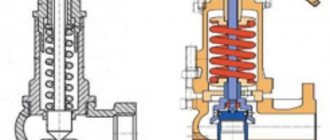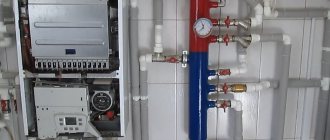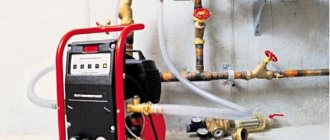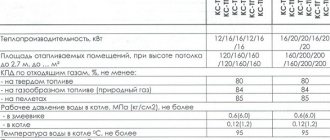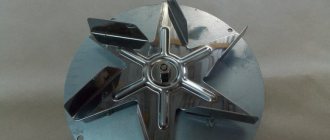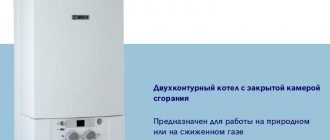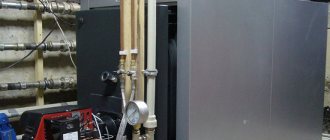Steam boiler flushing
During the operation of steam boilers, deposits of calcium, magnesium, iron, and silicon salts inevitably form on their internal walls.
The result of the presence of these chemical compounds inside the pipes and heat exchangers of the boiler is a decrease in the efficiency of its operation, and in some cases, equipment breakdown and failure occurs. Despite the similarity of the procedure for flushing a steam boiler with a household one, there are certain nuances related to the nature of the deposits. High temperature and pressure lead to the formation of complex compounds:
- Calcium sulfates;
- Hydroxyapatites;
- Magnesium-iron hydrosilicates;
- Iron phosphates.
It is impossible to destroy deposits of these substances using improvised means. Therefore, cleaning a steam boiler should be carried out by professionals who know which product is best suited for each specific case.
Our company uses equipment for washing steam boilers from the best brands, of which we ourselves are suppliers. We have been working since 2011 and have successfully completed thousands of projects in Moscow, other regions of Russia and neighboring countries. Our experience and knowledge allow us to cope with deposits inside steam boilers of any complexity.
Basic types of flushing
Scale hits the heating system multiple times:
- reduces the flow area of the pipes and heat exchanger, as a result of which the efficiency of the system drops sharply, and in some areas the pressure increases significantly;
- for the same reason, it forces the circulation pump to work with overload, which shortens its service life;
- Having the properties of a heat insulator, it worsens heat transfer, which also negatively affects efficiency and can lead to burnout of the heat exchanger.
Therefore, removing scale is included in the mandatory list of heater maintenance work. The DHW circuits of 2-circuit boilers are especially affected: here ordinary water from the pipeline is heated, in contrast to the prepared coolant, which is saturated with salts.
Signs of scale buildup on pipes and heat exchanger:
- clicking sounds are heard;
- gas consumption has increased;
- insufficient water heating;
- significant pressure drops (in heating systems).
There are two types of washing:
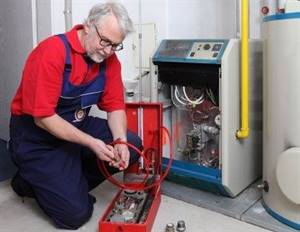
- regular or planned. Performed at certain intervals in order to prevent emergency situations. Does not require disassembly of the equipment and can be performed by the user himself. Typically, scheduled flushing is carried out every few years. For systems operating year-round, the time intervals between flushing are reduced;
- repair It is carried out at a critical thickness of the scale layer, when further operation of the boiler does not produce any effect or may result in an accident. It involves disassembling the equipment, therefore the participation of specialists is recommended.
Regular washing is carried out chemically using a special device - a booster.
What are the methods for flushing a steam boiler?
Steam boilers and heat exchangers belong to the category of industrial units with significant dimensions and large internal volume. This feature has its advantages and disadvantages from the point of view of the steam boiler cleaning procedure. There are special requirements for equipment for cleaning steam boilers and heat exchangers for them. At the same time, washing is not limited to just one method.
Depending on the wishes of the customer and the level of contamination, we can use the following methods for washing steam boilers.
- Hydrodynamic. Water is supplied to the system under high pressure, as a result of which coarse salt deposits are destroyed and coarse particles are removed. This type of flushing is capable of partially restoring normal circulation of the medium inside the boiler.
- Hydropneumodynamic. The steam boiler is flushed with an air-water slurry, which is supplied under pressure into the pipe cavity. The presence of air bubbles creates micro-water hammers, thereby increasing the degree of cleaning of the steam boiler and heat exchangers from deposits.
- Chemical. The destruction of salts is carried out through their transfer from an undissolved to a dissolved state, by exposure to special means for washing steam boilers.
It is worth noting that each of these methods of cleaning steam boiler heat exchangers individually does not give a 100 percent result. To achieve maximum results and completely remove all deposits, we recommend combining cleaning methods. For example, hydropneumodynamic cleaning with chemical washing of steam boilers works well.
Gas boiler cleaning
Methods for cleaning the heat exchanger
Removal of scale and soot can be done mechanically or using special chemicals.
Mechanical cleaning
The cleaning process takes place using a foam sponge, a brush with soft bristles, and a mini high-pressure washer. The most effective of the listed tools, allowing you to quickly remove plaque and destroyed layers of scale, is a mini high-pressure washer.
Before cleaning, in order for the reaction to proceed efficiently, it is advisable to apply a special liquid for removing carbon deposits to the radiator plates, or treat the surface with dishwashing detergent. You can combine two methods of removing dirt and pour descaling liquid into the coil. After 30 - 40 minutes, and with the combined method after 30 - 180 minutes (depending on the type of reagent used), thoroughly rinse the elements of the flow radiator with water under pressure.
Cleaning with chemical reagents
Dry cleaning can take place at a static or dynamic pace. When using the static method, the heat exchanger is removed from the water heater and filled with the active substance:
- Hydrochloric acid (H2SO4) with additives to prevent active reaction with metal (inhibitors). When acid comes into contact with a metal surface, the protective layer is damaged and the thickness of the coil wall becomes thinner, so inhibitors are added to it to prevent corrosive wear. After flushing the radiator, the spent acid residues from the coil must be neutralized with an alkaline solution, such as soda dissolved in water, before being poured into the sewer.
- Orthophosphoric acid (H3PO4). Neutral agent, reacts well with carbonates, does not harm the metal components of the system. An effective reagent is obtained by mixing H3PO4 and water in a ratio of 1/6.
- Aminosulfonic acid (NH3SO3) is an iron oxide remover. To prevent metal parts from being subject to premature wear when cleaning the boiler heat exchanger, a liquid consisting of corrosion inhibitors, water with a concentration of NH3SO3 in an amount of 2-3% is used.
- Citric (C6H8O7) or acetic (C2H4O2) acid. These substances are less dangerous to metal and humans than hydrochloric, orthophosphoric and aminosulfonic acid. But the decalcification reaction lasts several times longer than when treated with hydrochloric or phosphoric acid. If 30-40 minutes are enough to react with the same amount of H2SO4 scale, then for citric and acetic acid the time increases to 3-4 hours.
- Special liquid for descaling. Specialized stores sell certified substances, for example, Detex, Boiler Cleaner E, which easily deal with scale. After some concentrates, it is necessary to additionally treat the cavities with an acidity neutralizer, while others do not need to be treated with a neutralizer, since they are neutral to the components of the system. Service centers should use only certified fluids. If this rule is observed, the company is guaranteed to have protection against claims from the owner whose heat exchanger has leaked after chemical cleaning.
The dynamic method of removing carbonates is carried out with special boosters. A booster is a device designed to circulate scale-active liquid both through the heating system and through its individual components. The flushing liquid used is the same as for static cleaning.
The use of H2SO4 causes premature corrosion of the metal parts of the booster.
All activities are carried out outdoors or in a well-ventilated area, using personal protective equipment (goggles, rubber gloves) and clothing that well covers parts of the body in order to prevent acid and fumes from entering the human body. To improve the catalytic reaction and reduce processing time, the contacting liquid should be 50 - 60°C.
What are the differences between cleaning a double-circuit gas boiler?
How to rinse the secondary heat exchanger of a gas boiler with your own hands? There are no fundamental differences between flushing the DHW circuit and the heating heat exchanger. It’s just that in the case of a dual-circuit model, you will have to clean not one, but two elements.
Double-circuit gas boilers can be equipped with two types of heat exchangers:
- removable secondary;
- bithermic.
The first option is cleaned in the same way as the primary circuit using manual or chemical cleaning using a booster:
- connect the booster hoses to the pipes for cold water supply and hot water outlet;
- The apparatus is put into operation with the reagent heated (t=50-55ºC).
For manual cleaning, the secondary circuit is dismantled and immersed in a citric acid solution. Then brush the outside and dry.
A bithermal heat exchanger consists of two pipes inserted into one another: coolant flows through one of them, hot water flows through the other. Cleaning it is much more difficult, especially since such a circuit cannot be dismantled as a separate analogue. Therefore, flushing the bithermal circuit can only be done using a booster. If such an element is heavily contaminated, then it is simply impossible to clean it. Then you will have to buy a new bithermic heat exchanger and install it in place of the old one.
Procedure: how to clean the boiler from scale, soot and soot
If you decide to do the procedure for cleaning the structure yourself, before carrying out work at home, you need to turn off the electricity, turn off the gas, and close all valves of the heating system and boiler.
All actions should be carried out carefully; disassembly and assembly requires special care:
- The boiler cover is removed;
- Next, you should remove the gas burner, remove dirt in the form of carbon deposits from the electrodes, you can wash the surface with water and detergent, and rinse;
- Clean the injector and nozzles with a soft hair brush;
- Next, the fan is removed and its blades are cleaned;
- The wall of the AGV combustion chamber is removed;
- The heat exchanger should be cleaned of soot and descaled with citric acid or a special compound;
- Having dismantled the coil, it is necessary to clean the bottom of the boiler;
- Then the filter intended for cold water is cleaned, blown and rinsed with clean water;
- All parts are returned to their places;
- The tightness of the AOGV is checked.
After completing all the necessary procedures, you can open the gas valve and turn on the electricity.
When the boiler operates for a long enough time, contaminants in the form of carbon deposits gradually form on the burner. Accumulating in large quantities, it can cause equipment malfunctions. Therefore, it must be removed periodically.
For mechanical cleaning with small accumulations of dirt you will need:
- Brush;
- Yorshik;
- Thin needle.
The gas duct must be wiped clean. The surface of the nozzles is cleaned with brushes or a brush. A needle is used for holes. Under no circumstances should the hole be widened, as the combustion process may be disrupted.
If there is a lot of carbon deposits, you can use acidic solvents.
How to clean the heat exchanger of a floor-standing gas boiler
To disassemble a heating unit at home, you do not need any special tools; a regular set with screwdrivers, keys and pliers is sufficient. Preventive cleaning of the heat exchanger from soot and scale is carried out in the off-season, when the heating of the house is turned off. Having previously shut off the gas supply, we begin disassembling the boiler by removing the burner device in the following sequence:
- Disconnect all wires from the gas valve.
- Remove the thermocouple connected to the gas valve by a capillary tube from the combustion chamber.
- Disconnect the gas supply pipe.
- Unscrew the 4 nuts (or bolts) holding the stove with the burner. Pull the assembly out as shown in the photo:
The burner is removed together with the safety valve and mounting plate
The gas boiler burner can be cleaned without further disassembly using an old toothbrush. The igniter, piezoelectric ignition device and flame control sensor (if equipped) should also be cleaned of soot. Now you need to get to the heat exchanger, for which you need to remove the top cover of the boiler, disconnect the draft sensor and the chimney pipe.
In the opened opening you will see insulation covering the chimney casing. Carefully remove the insulation, and then unscrew the screws securing the casing and remove it. Below it is a heat exchanger, from which you need to remove steel turbulators, as is done in the photo:
When removing the turbulators from the heat exchanger, the soot spills downwards, so the first thing to do is remove the burner
Cleaning the turbulators is easy; this can be done with a regular brush with metal bristles. But cleaning the heat exchanger of a floor-standing boiler is best done with the help of simple tools made by yourself according to the size of the smoke pipes. If they have a rectangular cross-section, then you need to bend a convenient flat spatula and a small scoop-shaped scraper from thin metal, then nail it to a wooden handle.
For round flame tubes, these same tools are made slightly curved. First, the walls of the pipes should be cleaned with a scoop, after which the soot remaining in the corners should be removed with a spatula.
At the end of the work, all surfaces of the heat exchanger can be cleaned with a brush screwed to a long handle. The last step is to remove soot from the bottom, where it was poured when cleaning the smoke pipes. This is what a clean heat exchanger of a heating unit looks like:
You can take a closer look at how to clean a gas boiler at home in the video:
Watch this video on YouTube
How to clean the fire tube heat exchanger of a single-circuit boiler?
Cleaning floor-standing boilers with a fire tube heat exchanger differs from the same procedure for mounted equipment. Here, to carry out the procedure, the heat exchanger is not removed, but only access to it is provided.
To complete the work you will need the following tools:
- open-end wrenches;
- metal brush;
- hand brush for metal;
- screwdriver;
- natural bristle brush or nylon brush.
The first mandatory action is to turn off the gas supply valve. Next, you need to complete three stages of work - providing access to the heat exchanger, cleaning parts, and assembling the boiler. The disassembly/assembly steps depend on the specific model. How to clean boilers of the MAYAK-12 KS model can be seen in detail in the video.
Methods for cleaning a gas boiler
There are several options. These include traditional methods: mechanical and chemical methods. In not the most difficult cases, hydrodynamic cleaning is chosen. Sometimes serious help is needed.
Mechanical
This method involves the use of simple tools. Manual cleaning allows you to avoid wasting money and time, but its effectiveness is low. The mechanical method does not at all guarantee an excellent result, so its use can be called a half-measure. Actions with “crazy” hands will only help if cleaning is carried out regularly.
The role of tools is the usual tools - brushes, brushes, toothbrushes, and a vacuum cleaner is also used in the fight for cleanliness. All mechanical devices should not have sharp edges, since they can easily damage unit parts. The required element is disconnected from the system and carefully treated with brushes, trying not to damage the surface. To clean the inside, use a brush or blow out the parts with a vacuum cleaner.
Sometimes the mechanical method is combined with the chemical one. In this case, before “manual work”, small nodes are soaked in a container containing a weak acid solution. Use citric or hydrochloric acid: 100-200 g is enough for a bucket of water. After such a preliminary half-hour preparation, the scale is easier to remove, as it softens.
Chemical
This method is more effective than manual work. Chemicals allow you to remove blockages in places where tools simply cannot be reached. This option is not only more effective, it saves significant time. However, there are some downsides here. You have to pay for reagents, and for high-quality work you will need special equipment. You will either have to buy it or rent it from familiar craftsmen.
Cleaning with drugs
This option is suitable for small local contamination, but even in this case you need to act with extreme caution. Personal protective equipment required
Too much contact of elements with chemicals can lead not only to the removal of soot, but also to the destruction of the metal. Therefore, it is better to carry out processing very carefully.
Booster for cleaning the heat exchanger
Booster is a water pump with a container for a reagent. For maximum efficiency, the units are supplemented with heating elements. Instead of ordinary water, aggressive substances are used for cleaning. For example, solvents, orthophosphoric or hydrochloric acid. Heating them increases the efficiency of cleaning a gas boiler.
The booster is connected to the heat exchanger. When the device is started, the liquid begins continuous circulation inside it, gradually corroding all deposits. It is recommended to change the reagent, since it loses its properties, and all deposits enter the tank and accumulate there. To neutralize the remaining caustic liquid, after cleaning, a special (alkaline?) solution is passed through the pump. Or clean water.
Hydrodynamic
This flushing does not require disassembling the gas boiler, but a booster is also necessary for the procedure. This operation involves pumping water (in exceptional, severe cases, with an abrasive filler) with a subsequent increase in pressure in the system. The accelerated movement of the liquid provokes the destruction of deposits, and then their safe removal from the equipment. However, this option has serious consequences.
If a critical increase in pressure occurs, it can cause pipes to burst. Due to the potential danger of doing it yourself, it is better to leave such “water procedures” to the shoulders of professionals working with gas equipment. In this case, the owners of the gas boiler will be able to avoid all problems.
Electric discharge
This is another way to clean a gas boiler, but it requires serious equipment - a whole complex. In this case, the scale is exposed to a liquid through which an electric discharge is passed. Such a formidable treatment causes the deposits to crack and then be washed away.
The advantages of the method are a high degree of cleaning, no negative impact on metal parts of the equipment. Disadvantages: longer processing time, noisy procedure, expensive and voluminous equipment (Streamer complex). Such boiler washing is usually done only in service centers.
How often should the heat exchanger be cleaned?
The frequency of cleaning the gas boiler heat exchanger is usually indicated in the operating instructions. If there is a filter on the inlet water pipe, you can clean it less often. If there is no filtration and there is hard water in the region, the heat exchanger will clog faster.
Usually, without a water filter, cleaning is done once or twice a year. If tap water is filtered, it is enough to maintain the heat exchanger once every 4 years.
There are signs that the circuit needs urgent cleaning:
- Fuel consumption has increased - if the circuit is clogged, gas consumption can increase by 15-20%.
- The performance of the heating system has decreased. Signs of this may be the following: weak heating of the batteries, the unit cannot reach the required temperature and operates continuously.
- Weak water pressure from the hot water system or insufficient heating.
- Noises in the heat exchanger.
- An increased load is created on the circulation pump.
If at least one such “symptom” appears, you should clean the heat exchanger as soon as possible, otherwise inaction will lead to expensive repairs.
How to clean
There are two main methods for cleaning boiler units from scale:
- collapsible;
- in-place.
When using the disassembly method, you can sequentially dismantle parts that are contaminated with scale with your own hands. These parts are then placed in a container with a reagent for several hours. After this, these units are thoroughly washed with water and then put back in place.
The name of the in-place method speaks for itself, in other words, the boiler is cleaned of scale on the spot - without dismantling contaminated parts. In this case, cleaning the boiler unit from scale is carried out using a special device called a booster.
This device consists of the following components:
- container for chemical solution;
- electric fluid heater;
- circulation pump.
Flushing the boiler from scale using a booster is carried out in the following order:
- the boiler is turned off from the fuel supply or, in the case of a solid fuel option, the device is allowed to cool;
- water is drained from the boiler unit;
- disconnected from the heating system;
- the booster is connected;
- this device begins to pump the reagent through the boiler within 5–6 hours;
- the waste liquid is drained;
- the boiler is washed and connected to the heating system.
It is also worth knowing that to effectively remove scale using booster rinsing, the entire volume of operations must be repeated several times.
You may also be interested in an article on how to clean a gas boiler.
Read an interesting article about the features of flushing the heat exchanger of a gas boiler here.
Physical cleaning methods
If we are talking about cleaning the boiler from scale as a whole, then initially the cleaning is mechanical, and only then chemical.
Among the main disadvantages of the physical method, one can highlight the fact that the inner surface of the boiler is exposed to negative effects and therefore quickly deteriorates, especially if you carelessly choose too sharp tools
Once the boiler cleaning is completed, it is important to thoroughly rinse all removed parts with water and properly reassemble them.
Hydrodynamic cleaning of the boiler heat exchanger involves removing contaminants using a high-pressure water jet. This method differs from the mechanical one in that it eliminates any kind of damage to parts. Although hydrodynamics is very effective, it is not used very often due to its high cost.
There are two physical methods for cleaning boilers from scale.
Both options require mandatory disassembly of the system, which means that it is extremely important for anyone interested in such work to purchase the necessary tools and ensure full equipment. Since scale forms mainly on the surfaces of the boiler from the inside, it is impossible to interact with contaminated areas directly
Since disassembling the system is a labor-intensive and complex process, the cost of physically descaling devices is also high.
In private houses with a central water supply, water that has undergone disinfection and rough cleaning is used as a coolant for hot water supply and heating. This coolant contains large quantities of various suspended substances, including Ca and Mg, which, under the influence of high temperatures, more than 65 ° C, due to malfunction of the geyser modules, unsatisfactory water pressure, fall into carbonate sediment (CaCO3, MgCO3). Such deposits are called scale.
The scale adheres firmly to the metal surface inside the heat exchanger, pipeline, etc.
Low thermal conductivity of scale and good adhesion leads to:
- overheating of the tubes and plates of the heat exchanger, up to its damage;
- overconsumption of energy resources;
- reduction of water consumption due to overgrowing of internal pipeline channels and water heater elements;
- clogging of valves, taps and other system elements;
- reducing the thermal power of the device.
Over time, the outer part of the heat exchanger becomes covered with fuel combustion products. The formation of soot is promoted by the intense flame of a gas burner, poor draft in the chimney, unsatisfactory gas-to-air ratio, increased content of additional impurities in the fuel, and the ingress of contaminated condensate from the chimney. Soot affects heat exchange and leads to increased gas and water consumption.
Why does scale appear?
This type of contamination is the main problem in boiler operation. Scale forms wherever hot water circulates.
In other words, it settles as a hard layer on the inner walls of the boiler equipment.
What causes scale to appear? The reason for this clogging is very banal - the use of hard water as a coolant, which is well saturated with magnesium ions, calcium carbonate, iron oxide, as well as various other impurities.
When these elements interact with the internal walls of the heat exchanger, salts or bicarbonates are formed, which are the source of scale. It is also worth noting the important fact that on the walls that are covered with this contamination, scale will appear even faster and faster.
The result of such an increasing action will be a narrowing of the channels for coolant circulation, and this, in turn, leads to a loss of heat transfer and a decrease in pressure.
Important information:
1 mm of scale leads to an increase in fuel consumption by 10%!
Also, the negative impact of this pollution is that scale particles move freely throughout the heating system and, when they get into the heating elements, can render them unusable.
Therefore, the following recommendation is very important: removing scale in a timely manner will protect your heating boiler from breakdowns and malfunctions.
How to flush heating
You can purchase various reagents in the retail chain, offered in 3 types:
- liquid concentrate;
- powder;
- ready solution.
The concentrate and powder must be diluted with water, following the manufacturer's instructions. As a rule, before cooking, the water is heated to 40...60 °C. The finished liquid for flushing the heating system is poured into a barrel and disposed of after use.
We will give a number of recommendations on the best way to flush heating pipes:
- The active ingredients of the reagent should not damage the elements of your system, for example, interact with aluminum radiators. Choose chemistry taking into account the materials from which metal parts and fittings are made.
- It is better to buy washing with various useful additives - corrosion inhibitors, biodegrading additives.
- Based on their composition, the reagents are divided into 2 groups – acidic and alkaline. The former act faster, but are considered more aggressive towards equipment and hazardous to health. It is better to choose an alkaline concentrate.
We do not recommend using various folk remedies for washing, in particular citric acid. Firstly, it is only effective against scale, which is found only in boiler heat exchangers. Secondly, a high concentration of the acid solution is required; with a large amount of water it cannot be achieved.
When is cleaning possible?
In any case, it is inappropriate to wait until the moment when the device turns into a grimy “Cinderella”, so cleaning the gas boiler from soot is carried out at a certain time. There are three options.
- Periodic maintenance. It is a necessity. Owners are recommended to perform preventative cleaning of equipment at least once every 2 years. Better - once a year.
- Such a “cleaning” operation is required when the efficiency of a gas boiler decreases: heating of water for hot water supply is worse, heating does not work well enough. Usually in such circumstances a professional is called.
- Cleaning a gas boiler from soot during repair work. When a heat generator breaks down during the heating season, the technician who comes to fix it also does preventive maintenance - cleans the heat exchanger.
The first 2 cases are not very attractive for equipment owners, since they involve expenses due to the invitation of an “alien” master. Often you can handle cleaning yourself, but almost any rule has exceptions. For example, it is better not to experiment with a condensing boiler that has a closed combustion chamber. If the owner is completely unfamiliar with such a unit, then professional help is already a necessity.
Preventative cleaning of a gas boiler from soot - flushing the heat exchanger - is a simple operation, and it is also performed quite quickly. This procedure can be carried out independently without much difficulty.
There are certain symptoms that indicate the need to clean your equipment. These include:
- increased gas consumption due to clogged heat exchanger;
- an atypical hum inside the device due to pump overload;
- reducing water pressure in the DHW circuit;
- radiators that are not hot enough;
- constantly working burner.
All these signs may not only be symptoms of a clogged unit, so other possible causes of problems should also be taken into account when diagnosing the equipment yourself.
Disassembling and removing soot from the inner surface of the boiler
In order to clean the entire system at home, you will need the following tools:
- screwdriver;
- metal brushes (soft and for metal);
- brush;
- open-end wrenches;
- rags or any cotton fabric.
Stages of work:
- Turn off the gas.
- Remove the boiler door and disconnect the wire leading to the piezoelectric element.
- Unscrew the thermocouple, ignition electrode and pilot burner tube one after another.
- Replace with a new gasket under the pilot burner.
- Remove the nozzle, copper tube, burner.
- Carefully remove the thermometer sleeve, and then remove the boiler lid along with the insulating sheet.
- Disconnect the terminals from the traction sensor and remove the gas duct.
Before cleaning, turn off the gas supply, wait for the structures to cool completely and only then disassemble.
After removing all the parts, you need to:
clean with a brush and metal brushes. The channels should be blown out with a vacuum cleaner. Particular attention should be paid to the burner, since the internal channel can be easily damaged; it must be wiped carefully.
Wood boilers are often used for heating in homes. And only a few people think about what kind of firewood they should choose for kindling. Usually they use everything they have. Firewood containing resin causes particular harm to chimneys. It settles on the walls of the boiler and the chimney pipe. Mechanical cleaning is required. In this case, the chimney must be cleaned from the roof to remove any remaining tar and soot, so that combustion residues will be easier to remove from the inside. Observe safety precautions!
Causes of clogged heating system
The main source of contaminants that disrupt the operation of thermal circuits is the coolant. This is most often tap water. When filling the system, small debris from the water supply can easily get in with it. As the water circulates, this debris is transferred to the radiators, where it accumulates.
Another source of contamination is scale. It is formed in the boiler, where water comes into contact with the hot walls of the heat exchanger. Gradually, the inside of the boiler becomes covered with a layer of scale, which has relatively low thermal conductivity. A heat exchanger coated with scale transfers energy to the coolant much worse. With a thickness of salt deposits of several millimeters, the efficiency of the boiler can decrease by almost a third. During the process of cyclic heating and cooling, the scale crust is destroyed. The exfoliated particles enter the pipeline and are deposited both on the inner walls of the pipes and in the radiators. Accordingly, their heat transfer decreases and there is reason to think about how to flush the heating system in a private house with your own hands.
In addition, due to the oxygen contained in the water, rust gradually forms in the metal elements of the system. Like scale, rust increases the hydraulic resistance of pipes and is an additional source of contamination.
What determines the cost of flushing a steam boiler?
The cost of cleaning steam boilers from scale and other deposits is calculated for each client individually and depends on the following factors:
- the number of steam boilers requiring flushing;
- degree of contamination;
- difficulties connecting our equipment;
- the amount of money spent in the case of chemical washing.
The exact price for flushing a steam boiler is established only after a direct visit of our specialist to the site and inspection.
How long does it take to flush the boiler?
As a rule, washing of household boilers takes from 2 to 6 hours, depending on the degree of contamination.
You can judge the effectiveness of washing by the following signs: the appearance of foam, cloudiness of the solution, an increased pungent odor, an increase in the amount of solution in the expansion tank.
These signs indicate the presence of a reaction, which means the dissolution of scale.
When washing, you should maintain a temperature of about 50-60°C and monitor the acidity of the washing solution.
Yes, by the way, about measuring pH. It is advisable to buy indicator strips for measuring acidity with indicators from 1 to 14 units (the most acidic and most alkaline environment). During the reaction, the acidity of the solution gradually decreases, the color of the indicators shifts from dark red to yellow (towards a neutral solution).
How safe is it to clean a steam boiler?
Regardless of the chosen method for flushing the steam boiler, we guarantee that the procedure will not affect the condition or performance of the heat generator. Our specialists know how to calculate the value of excess pressure during mechanical cleaning and the amount of active agent for chemical cleaning.
In addition, the reagents used are a product of our own production, which is made with strict adherence to German technology. They have passed laboratory tests for biodegradability in natural environmental conditions and meet the requirements of the sanitary and epidemiological service.
Aquatechno products do not have a negative effect on pipes, seals or other elements, as with “handicraft” acid washing of steam boilers. The anti-corrosion substances included in the reagents form a protective film, which for some time protects parts from the appearance of new deposits.
Carrying out acid washing
Before carrying out the procedure, it is necessary to drain all the water from the equipment, and then connect a unit to it, which will carry out the washing. A special reagent consisting of several acids is pumped into the container, after which it begins to circulate through all the pipes. The duration of the procedure depends on the degree of contamination of the boiler. It can take either 4 or 7-8 hours.
Specialists involved in the process must monitor each stage and monitor the color change of the solution that is being washed, as well as pay attention to pH tests. This is necessary to determine the exact time when you need to add another portion of the solution, because it is consumed during washing. Once the acidity reaches pH 2, the procedure can be completed. The solution and deposits must be drained from the boiler and taken care of for disposal. You need to pour water into the boiler to cleanse it of any reagent that might remain on its walls.
Why us
Our company is officially registered. We have the necessary documents to provide steam boiler cleaning services to enterprises of any form of ownership and field of activity. We cooperate with both private entrepreneurs and large factories. We work with all forms of payment: cash, non-cash, bank transfers.
To order or find out more about flushing our company’s steam boilers, just contact us in any convenient way specified in the contacts.
What are the restrictions on hydrodynamic cleaning?
Hydraulic cleaning of boilers is applicable only to drum steam boilers E, DE, KE or DKVR.
This is due to the fact that the above boilers have access to screen and convection tubes. In boilers E, DE, KE or DKVR, the specialist performing hydrodynamic cleaning of the boiler is located inside the drum and performs work on even the most inaccessible tubes.
In this regard, there are restrictions for water heating boilers PTVM, KVGM, ZIO for cleaning using a hydrodynamic method, since the collectors of these boilers do not have hatches for comfortable access for a flushing specialist.
For the same reason, some fire-tube boilers cannot be washed completely, but only from the top or from the end using hydrodynamic cleaning, because it is in these places that they have access to the pipes. These include the following boilers: Booster, Ferolli, Babcock Wanson, De Dietrich, Buderus, ICI, IVAR, BOSH UL-S, Unical Bahr, Viessman.
Most often, high-pressure hydrodynamic cleaning is carried out in combination with chemical treatment of the boiler, when something that could not be removed by chemical washing is removed.
Estimated cost of services
The cost of work is determined based on the boiler model, location, heat exchange surface area, water volume and degree of contamination.
The cost of work is determined based on the heat exchanger model, location, heat exchange surface area, and water volume.
What explains the need to flush boiler and heat exchange equipment with chemical reagents?
In practice, the quality of water for heating networks does not meet established standards. Failure to comply with the regulations when putting the system into operation starts the process of deposition of excess salt and other impurities on the surface of the pipes. In this regard, the hydraulic regime is disrupted, the useful volume of the networks is reduced, which leads to a complete imbalance and threatens the integrity of the system. It is not possible to carry out mechanical cleaning of pipes and equipment due to the lack of technical potential, so chemical flushing becomes perhaps the only and most effective method of cleaning the system.
What stages do we go through when cleaning industrial boilers?
Hydrodynamic boiler flushing has a mandatory 9 stages. Here they are.
1. Draining water from the boiler
2. Opening the hatches of the upper and lower drums
3. Dismantling the steam separator
4. Cleaning of each boiler tube by a specialist located inside the upper drum
5. Final washing of the upper drum.
6. Cleaning screen and convection pipes
7. Opening and washing the collector
8. Washing the lower drum
9. Removing sludge and scale from the lower drum.
Features of the use of acids for cleaning heat exchangers
During the chemical reaction between acid and salts, carbon is formed; due to the risk of explosion, it should not come into contact with air. To avoid the threat of explosion, it is necessary to ensure that there is no oxygen in the solution; the system must be protected from the penetration of atmospheric air. In addition, there should be no potential ignition sources near the flushing area.
For washing heat exchangers and metal pipelines, it is most reliable to use acidic solutions with a pH level of 2-4. Higher acidity can negatively affect the metal walls of the pipes and lead to their damage.
The chemical method allows you to effectively remove accumulated deposits of any type and restore the original internal diameter of the pipeline. As a result, the pressure level in the system is normalized, and the heating boiler will ultimately operate for a long time and without failure. It is recommended to flush heating equipment 1-2 times a year, this avoids contamination and ensures trouble-free operation.
Metal corrosion inhibitors can be used during the washing process. Special passivation substances form a thin film on the inner walls of the pipeline, which prevents damage by corrosion. As a result, the system will last much longer.
What else do you need to know about cleaning industrial boilers?
By flushing boilers we mean a set of measures during which, using physical or chemical methods, deposited scale is removed from the boiler and heat exchanger. There are two types of boiler flushing: regular and repair. With regular flushing of boilers, small amounts of scale are removed from contaminated parts of the boiler installation, while repair flushing of the boiler is carried out in cases where regular flushing no longer helps.
Regular flushing of a steam boiler usually does not require disassembling the system and is carried out using special boiler flushing equipment. This method allows you to prevent the occurrence of large amounts of scale and thus prevent some possible emergency situations associated with clogging of the system. When operating a boiler installation, the contamination of which prevents the normal circulation of coolant through the system, there is a risk of mechanical damage to the boiler installation caused by an increase in pressure inside the system, which is why it is so important to carry out regular flushing of the boilers.
Repair flushing of the boiler usually involves disassembling the system. This measure is usually carried out in situations where the degree of contamination of the boiler installation is assessed as high, and further operation of the equipment is unsafe. Similar situations arise in the absence of regular boiler flushing for a long time, which leads to disruption of coolant circulation in the system. Most often, repair boiler flushing is carried out using physical methods, but it is also possible to use chemical boiler flushing in combination with mechanical cleaning.
The lack of regular flushing leads to clogging of the system, and operation of a clogged boiler installation without repair flushing of the boiler can lead to accidents in the boiler room, which is why timely flushing of boilers is so important.
Flushing the boiler from scale: consequences of ignoring
Modern mains use ordinary hard water, which quickly leads to the inside of the equipment being covered with scale. Boilers must be cleaned on a regular basis. If cleaning is not done on time. The consequences can be the most unpredictable, but definitely unpleasant.
The design of the gas boiler is such that the coolant coming from the return line cools the cavities of the heating elements located inside. The coolant cannot effectively cool the elements if they are covered with a thick layer of scale. If the boiler constantly overheats, it will soon stop working altogether.
What will happen if you ignore flushing?
- Scale consists of mineral deposits that do not promote thermal conductivity. Scale causes the water to heat up slowly, which requires significantly more electricity. A thick layer of scale leads to increased gas consumption, which increases the price of using the boiler.
- Scale can lead to boiler failure due to difficult coolant passage. This increases the load on the circulation pump, which leads to its rapid breakdown.
Before flushing the boiler, it is important to pay attention to what kind of liquid flows through the line. The need for frequent flushing will be due to very hard and contaminated water. In order to reduce the frequency of cleaning, it is necessary to use antifreeze - it is important that it is not expired
In order to reduce the frequency of cleaning, it is necessary to use antifreeze - it is important that it is not expired
